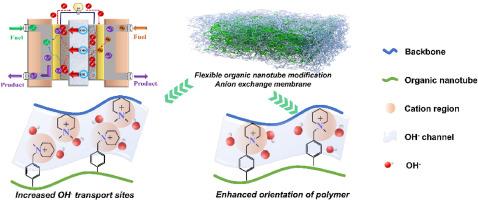Conductivity-enhanced Poly(biphenyl piperidine) anion exchange membranes with organic tubes
IF 8.4
1区 工程技术
Q1 ENGINEERING, CHEMICAL
引用次数: 0
Abstract
Anion exchange membrane fuel cells (AEMFCs) present an economically efficient alternative to proton exchange membrane fuel cells because of the use of non-precious metals. The development of high-performance and durable AEMFCs necessitates the use of highly conductive and robust anion exchange membranes (AEMs). In this study, a novel organic-organic composite AEM was synthesized by preparing poly(arylene piperidinium) polymer through Friedel-Crafts acid condensation and incorporating one-dimensional organic tubes as reinforcing materials. The composite AEM exhibits high conductivity (235 mS cm−1 at 80 °C) due to the chain orientation within the organic tubes and the availability of abundant transport sites. Furthermore, in contrast to the incompatibility of inorganic materials with polymers, the flexible nature of organic tubes enhanced polymer entanglement, significantly boosting the mechanical strength (120 MPa) of the AEM. Crosslinking the polymer backbone with the organic tubes facilitated simultaneous swelling, effectively mitigating interfacial compatibility issues, result in high dimensional stability. The H2–O2 fuel cell employing the developed AEM demonstrated a peak power density of 1018 mW cm−2 at 80 °C. This study provides a comprehensive synthetic strategy for producing stable AEMs with high hydroxide ion conductivity and outstanding mechanical properties tailored for alkaline membrane fuel cell applications.

带有机管的电导增强型聚(联苯哌啶)阴离子交换膜
阴离子交换膜燃料电池(AEMFC)由于使用非贵金属,因此是质子交换膜燃料电池的一种经济高效的替代品。要开发高性能和耐用的 AEMFC,就必须使用高导电性和坚固耐用的阴离子交换膜(AEM)。本研究通过 Friedel-Crafts 酸缩合法制备了聚(芳基哌啶)聚合物,并加入一维有机管作为增强材料,从而合成了一种新型有机-有机复合 AEM。由于有机管内的链取向和丰富的传输位点,复合 AEM 表现出很高的电导率(80 °C 时为 235 mS cm-1)。此外,与无机材料与聚合物不相容相反,有机管的柔性增强了聚合物的缠结,从而显著提高了 AEM 的机械强度(120 兆帕)。聚合物骨架与有机管交联可促进同时溶胀,有效缓解界面兼容性问题,从而实现高尺寸稳定性。采用所开发的 AEM 的 H2-O2 燃料电池在 80 °C 时的峰值功率密度为 1018 mW cm-2。这项研究为生产稳定的 AEM 提供了全面的合成策略,AEM 具有高氢氧根离子电导率和出色的机械性能,适合碱性膜燃料电池应用。
本文章由计算机程序翻译,如有差异,请以英文原文为准。
求助全文
约1分钟内获得全文
求助全文
来源期刊

Journal of Membrane Science
工程技术-高分子科学
CiteScore
17.10
自引率
17.90%
发文量
1031
审稿时长
2.5 months
期刊介绍:
The Journal of Membrane Science is a publication that focuses on membrane systems and is aimed at academic and industrial chemists, chemical engineers, materials scientists, and membranologists. It publishes original research and reviews on various aspects of membrane transport, membrane formation/structure, fouling, module/process design, and processes/applications. The journal primarily focuses on the structure, function, and performance of non-biological membranes but also includes papers that relate to biological membranes. The Journal of Membrane Science publishes Full Text Papers, State-of-the-Art Reviews, Letters to the Editor, and Perspectives.
 求助内容:
求助内容: 应助结果提醒方式:
应助结果提醒方式:


